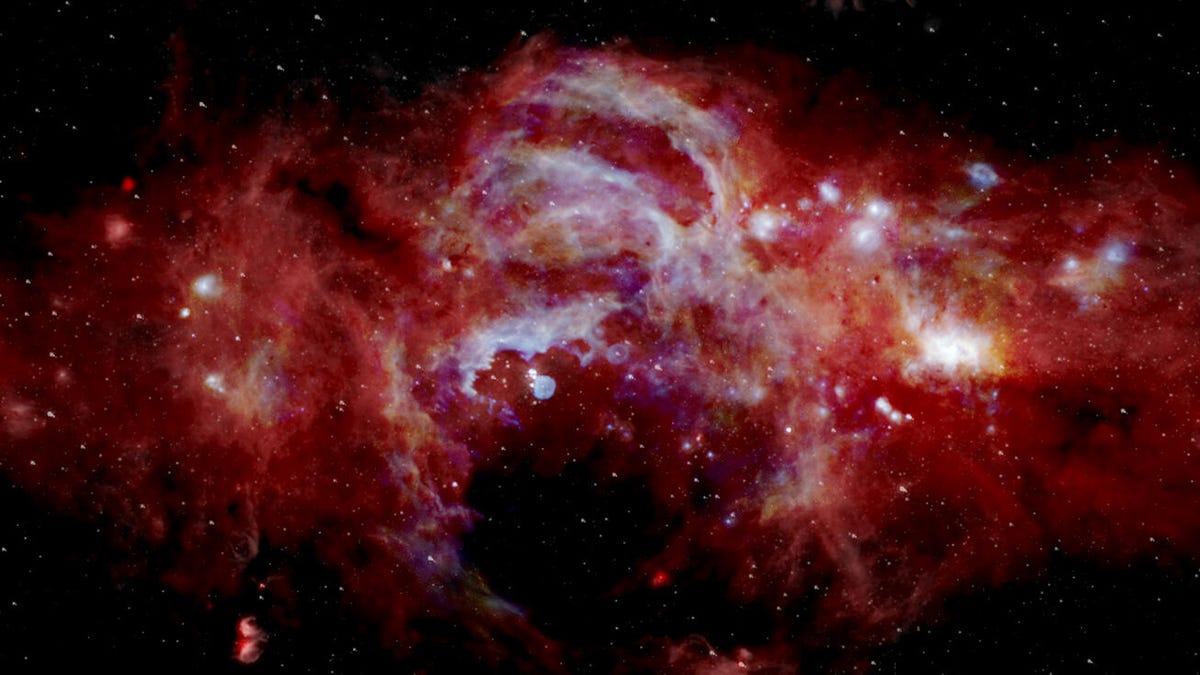Astronomers discover unexplainable gas clouds at Milky Way's center
Cold gases shot out of our galaxy's center challenge our understanding of the galactic wind.

The core of the Milky Way is windy and mysterious.
The center of the Milky Way, where our galaxy's supermassive black hole lies, is a weather forecaster's dream. It's easy to remember "always windy." The region is volatile, filled with gas clouds and high-energy particles whipped up by the black hole, Sagittarius A* (Sgr A*), and stars close to the galactic center. This creates a wind of gases that shoot out deeper into the galaxy and eventually into the dark void of space.
Astronomers have found evidence for hot, warm and cool gases in the wind, ranging in temperatures from around 1,000 degrees Fahrenheit to as high as almost 2 million degrees Fahrenheit. In a study, published in the journal Nature on Wednesday, researchers report the existence of cold gas clouds, challenging some of the beliefs about the processes in our galaxy's core.
"The standard explanations for the Milky Way's wind are that it is either driven out by an explosive event associated with the black hole or the winds from supernovae and stars," says Naomi McClure-Griffiths, an astrophysicist at the Australian National University and co-author of the new study.
"Yet, neither of them work to explain these clouds."
McClure-Griffiths notes galactic winds are an important process in the life cycle of galaxies. Understanding what might be happening in our galactic center will help us answer lingering questions about how galaxies evolve over time. To understand what might be happening in the wind surrounding the galactic center, the research team pointed both the Atacama Pathfinder Experiment (APEX) telescope in the Chilean desert and the Australia Telescope Compact Array at clouds within a region of the galaxy known as the Fermi bubbles.
These bubbles form the outer limits of the galactic wind and are gargantuan, extending about 50,000 light years from the Milky Way's disk. If you could observe the galaxy from the outside, you'd be looking at something akin to a pizza resting on a soccer ball, with a second soccer ball balanced on top of the pizza. Delicious?
The research team analyzed two clouds within the bubbles, known as MW-C1 and MW-C2. By looking for the telltale radio signature of carbon monoxide they could characterize the clouds and resolve some of their features. They discovered the gases were much colder than previously described gases in the Milky Way's wind and we're moving very quickly.
"In terms of temperature, the difference between hot and cold gas is about a factor of 1,000," says McClure-Griffiths. She notes the cold gas is around -350 degrees Fahrenheit and "very dense," which makes it a lot more difficult to move compared to the diffuse, hot gas.
"A way to think of this is that you can blow smoke away from your face but you couldn't blow a rock away from your face," she says.
Studying other galaxies, previous research has shown the presence of cold gas clouds, but they are found in galaxy's unlike our own, with bigger black holes and much great star formation activity. Previously described processes in the Milky Way's center suggest the clouds shouldn't be able to survive being shot out of the core like this, so the discovery is a puzzling one. "We really don't know what's going on now!" notes McClure-Griffiths.
But, she says, her true love is understanding how things work -- and the center of the Milky Way provides a fabulous laboratory to examine how the galactic wind works. Future work will examine more clouds in an effort to resolve how they persist after being rocketed out of the galactic center.
"We have an approved project with the European Southern Observatory on the APEX telescope to look for many more clouds," says McClure-Griffiths. "With a bigger sample over a wider area of the sky we expect to be able to understand what the physical processes are."

